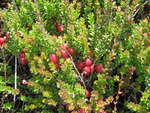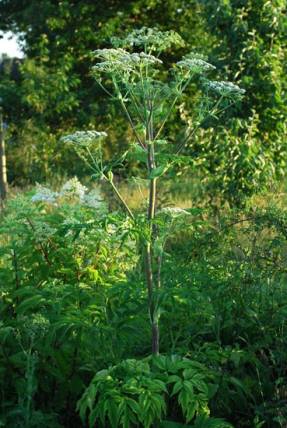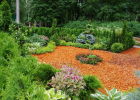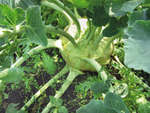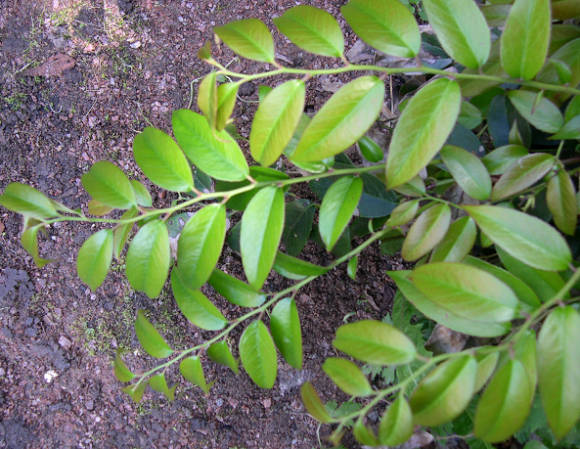Common blueberry (Vaccinium myrtillus) - the most popular among forest and marsh plants. It got its name from the color of its berries. Other popular names are chernega, chernia, blueberry, drywort, etc.
It is a highly branched shrub from the lingonberry family 15–40 cm high with a long creeping rhizome and sharp-ribbed green branches. Blueberries grow in coniferous and mixed forests in flat, semi-shady places. Its leaves are on short petioles, alternate, light green.

Growing blueberries
Loose, slightly acidic soil is best for growing blueberries. You can prepare a soil mixture from peat, sandy soil taken from a coniferous forest, and soil from the site chosen for planting.
The place for planting is chosen in the shade, under trees, best of all under conifers. In this place, you need to dig a trench 25 cm deep, of arbitrary width and length, and fill it with this soil mixture. Planks must be installed in the trench so that they rise 10 cm above the soil level in order to keep the mulch within the garden bed.
Before planting, the roots of the seedlings must be kept in water at room temperature for 24 hours. Planting plants is best done in grooves dug at a distance of 20 cm from each other. At the bottom of the grooves, the prepared soil mixture is poured with a layer of 7–8 cm, the roots are laid on it, sprinkled with soil mixture on top, compacted and watered abundantly with water. For 1 sq. a meter of a ridge is planted in 15-16 bushes. Then the soil is abundantly mulched with needles or moss, it is possible with fallen leaves or sawdust.
Blueberries do not require special care in the garden. Over the summer, it must be poured 3 times with acidified water (0.5 cups of 9% vinegar per 10 liters of water). It is impossible to loosen the soil with a hoe, so as not to damage the roots.
Blueberry medicinal raw material
Blueberries have been very popular in medicine for a long time. Its berries are black with a bluish bloom, which is why they were nicknamed "raven berry" in the old days. They have a spherical shape, their flesh is tender and juicy, reddish-purple, with numerous small seeds. The taste is pleasant, sweet and sour, astringent.

Blueberries bloom in May – June, berries ripen in July – August. It is advisable to collect them in dry weather. When harvesting for the winter, the berries are preliminarily dried in a dryer at a temperature of 40 ° C for 2-3 hours, and then dried in the same place, but already at a temperature of 50-65 ° C.
It is impossible to dry the berries at a higher temperature, since they bake or burn, and at a lower temperature they turn sour and moldy. Well-dried berries are very wrinkled, do not stain your hands and do not stray into dense lumps.
For medicinal purposes, ripe berries without stalks are used, as well as leaves collected during flowering. The smell of dried berries is weak, the taste is slightly astringent, sour-sweet.
The chemical composition of blueberries
Blueberries have the richest chemical composition. They contain up to 7% sugars, up to 1.5% organic acids (citric and malic), up to 0.6% pectin and a lot of tannins.
Of the vitamins, they contain carotene - up to 1.5 mg%, vitamin C - up to 6 mg%, B1 - up to 0.05 mg%, B2 - 0.04 mg%, a large amount of P-active compounds (up to 400-600 mg%) and nicotinic acid.
Blueberries are an excellent source of trace elements, especially iron and manganese, for the content of which they rank first among all berries and fruits. Blueberry leaves contain a lot of vitamin C and tannins, glycosides, a lot of essential oils and tannins.

Medicinal properties of blueberries and recipes for use
Since ancient times, blueberries have been used as a mild yet effective astringent for upset stomach and intestines, regulating their work. In case of indigestion, it strengthens the stool, and in case of constipation, it weakens, regulating the work of the intestines.
To prepare a medicinal infusion for indigestion, 1 tbsp. pour a spoonful of berries with 1 glass of boiling water, wrap and insist in a warm place for 2 hours, drain. Take an infusion of 0.3 cups 4-5 times a day.
Chronic diarrhea should be treated with stronger decoctions. To prepare it, you need 2 tbsp. spoon berries pour 1 cup boiling water and cook over low heat for 20-25 minutes. A decoction of blueberries is especially useful for diseases of the gastrointestinal tract in children.
The tannins contained in blueberries cause the bacteria to clot protein and promote the healing of ulcers in the intestinal mucosa. This broth is also useful for heartburn and putrid fermentation in the intestines. For the same purposes, blueberry fruits are often boiled together with bird cherry fruits. To do this, take 1 tbsp. spoon each for 1 glass of boiling water.
A good astringent effect is possessed by a collection consisting of 2 hours of blueberries, 1 hour of immortelle flowers, 1 hour of caraway seeds, 3 hours of sage leaves and 1 hour of Potentilla rhizomes. To prepare the broth, you need 1 tbsp. pour a spoonful of collection with 1 glass of boiling water, boil over low heat for 10 minutes, strain. Take a decoction of 0.5 cups 3 times a day 20 minutes before meals.
Pectins contained in berries adsorb and remove intestinal toxins from the body, including compounds of lead, strontium, cobalt. Blueberries are useful for stomach and intestinal catarrh with low acidity.
Bilberry berries and leaves are included in numerous medicinal preparations, and medicinal preparations from them are easy to prepare at home.
For gastritis with low acidity, herbalists use a collection consisting of 3 hours of blueberry leaves, 4 hours of knotweed herb, 4 hours of St. John's wort, 2 hours of yarrow inflorescences, 2 hours of immortelle flowers, 1 hour of mint leaves, 1 hour. chamomile flowers.
To prepare the infusion, you need 1 tbsp. pour a spoonful of the mixture with 1 glass of cold water, leave for 9-10 minutes, heat to a boil and simmer over low heat for 6-7 minutes, insist in a warm place for 20 minutes. Take 1 glass 4-5 times a day 30 minutes before meals.
With the same disease, another complex collection is used, consisting of 3 hours of blueberry leaves, 8 hours of plantain leaves, 8 hours of marsh cumin leaves, 1 hour of caraway seeds, 2 hours of calamus bark, 2 hours of mint leaves, 4 hours St. John's wort herbs, 4 hours knotweed herb. To prepare the infusion, you need 1 tbsp. pour a spoonful of collection with 0.5 liters of boiling water, insist in a thermos for 8 hours. Take 1 glass of infusion on an empty stomach, and then during the day 4 more times for 0.3 glasses of infusion.
Blueberries and strawberries, together or in turn, must be consumed for a long time with urolithiasis.
For kidney stones, healers have long used a collection consisting of 1 teaspoon of blueberry leaves, 1 teaspoon of beans, 1 teaspoon of thorn flowers, 1 teaspoon of yarrow herb, 2 teaspoons of horsetail herb, 2 teaspoons of St. John's wort. To prepare the infusion, you need 1 tbsp. pour a spoonful of the mixture with 1 glass of cold water, leave for 6-8 hours, bring to a boil, leave for 10 minutes and strain. Take the infusion, slowly, 1 glass 2 times a day.
Blueberry Recipes:
- Pizza with blueberries and cognac
- Christmas carols (gates, sweet food)
- Fresh berry parfait with liqueur and cognac
- Creamy blueberry and goat cheese cake
- Elderberry (or blueberry) pie
- Blueberry tea "Starorussky"
- Flip "Moscow"
"Ural gardener", No. 30, 2018

